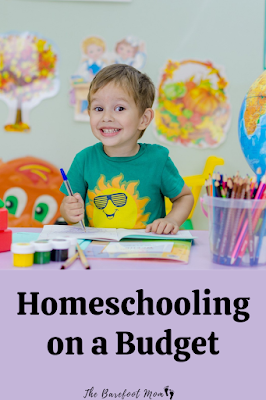Homeschooling can get pricey, especially if you have multiple children, but it doesn't have to be. Homeschooling can actually be done very affordably if you search for freebies and good deals, or you can save money by putting together your own curriculum. We generally spend no more than a few hundred dollars a year, and that includes restocking our craft and general school supplies. In this post I share my best tips for homeschooling on a budget.
Use Your Local Library:
Instead of buying expensive text books, try checking out lots of books on whatever topic you are studying from your local library. A stack full of library books written by a variety of authors from a variety of perspectives is always going to give a more rounded view of a topic than a single text book anyway.
Libraries also often have educational DVD's, audio books, educational magazines, story time for preschoolers, and many other resources available for free or low cost. We LOVE our local library's weekly story and craft time. We went every week when my older daughter was preschool and kindergarten age and will probably start going again soon now that my younger daughter is old enough to sit still for a story.
Use Free Online Resources:
I find tons of free printables and worksheets online. These sites have lots of free and low cost printables for a wide variety of ages and topics:
-123 Homeschool 4 Me: FREE Printables
And that's just a few. There are tons of other sites out there with free homeschool printables.
Another awesome free online resource is YouTube. You can find educational videos on just about any topic under the sun on YouTube. My daughter has been taking free French lessons on YouTube on and off all year with Learn French With Alexa.
Here are a few more of our favorite YouTube channels:
For a more complete list of educational YouTube channels for kids, check out this blog post: The Ultimate List of Educational YouTube Channels for Kids
Pinterest is awesome too! There are so many great learning ideas and craft and science experiment ideas on Pinterest.
Homeschool blogs are another great resource. Whatever you are studying, chances are someone else has already done it and blogged about it.
A few more of my favorite free online homeschool resources:
Pinterest is awesome too! There are so many great learning ideas and craft and science experiment ideas on Pinterest.
Homeschool blogs are another great resource. Whatever you are studying, chances are someone else has already done it and blogged about it.
A few more of my favorite free online homeschool resources:
-Easy Peasy All-In-One Homeschool (this one is a complete K-12 curriculum that is 100% free!)
Buy Used and Barter:
A lot of curriculum books can be reused. Amazon offers the option of buying used. You can also search facebook for curriculum swaps and used curriculum sale groups. If your area has any active homeschooling groups, see if you can organize a curriculum swap day. It's a great way to get your hands on really great curriculum for very little money.
Take Advantage of Free Community Resources:
Research and visit the neat historical and geological sites in your area. Take lots of nature hikes. Participate in community events. Do math at the store. If you look around and get creative, there are tons of learning experiences just waiting to be had everyday.
Build Your Own Curriculum:
Skip the fancy curriculum sets and build your own. It's easier than you might think. Check out library books and scour the internet for ideas.
If you enjoyed this post, check out:




I love your suggestions, because we continually need new homeschool opportunities and curriculum!
ReplyDeleteThanks! We too are continuously searching for new curriculum and ideas.
Delete